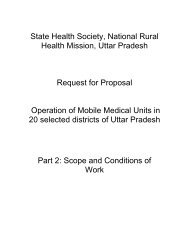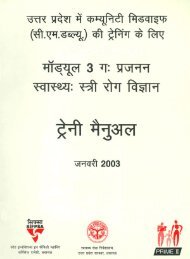MODULE 1: Infection Control and Waste Management - State ...
MODULE 1: Infection Control and Waste Management - State ...
MODULE 1: Infection Control and Waste Management - State ...
Create successful ePaper yourself
Turn your PDF publications into a flip-book with our unique Google optimized e-Paper software.
Clean the inside of the chamber daily using a cloth. This will prevent build-up of scale<strong>and</strong> will allow the sterilizer to operate more efficiently. To clean the inside chamber,follow these steps:• Turn the unit off <strong>and</strong> allow chamber to cool.• Remove all trays <strong>and</strong> racks.• Using towels soak <strong>and</strong> remove any water lying in the bottom of the autoclave.• Wipe the inside of autoclave with clean towels.• Finally, using a moist towel, wipe the gasket clean on the inside of the door.1.8.3 Chemical SterilizationChemical sterilization is used for instruments <strong>and</strong> other items which are heat sensitive orwhen heat sterilization is unavailable. Items can be sterilized by soaking in 2%glutaraldehyde for 8 -10 hours followed by rinsing with sterile water. As glutaraldehydeis an irritant to eyes, skin <strong>and</strong> respiratory tract, use, mask <strong>and</strong> glove while exposed.Commercially available glutaraldehyde (Cidex®) can be used for 14 days <strong>and</strong> should bediscarded after that. Solutions must also be replaced whenever become cloudy.Steps of Sterilizing the Items through Chemical Sterilization –1. Decontaminate, clean <strong>and</strong> thoroughly dry all the items to be sterilized. Water fromwet instruments or other items, can dilute the chemical thereby reducing itseffectiveness.2. Prepare chemical solution by following the manufacture’s instruction or usesolution which is already prepared as long as it is clear <strong>and</strong> has not expired.3. Pour the solution in a clean container with a lid. Open all hinged instruments,disassemble those with sliding or multiple parts <strong>and</strong> dip them completely in thesolution. No part of the item should remain outside the solution.4. Remove instrument with a large sterile forceps after 8 – 10 hours.5. Residue of chemical solution should be washed off by rinsing the item with sterilewater. Boiled water is not sterile as it does not kill the bacterial endospores.sterile water can be obtained from the autoclave <strong>and</strong> stored in sterile bottles.6. Place instruments <strong>and</strong> other items on a sterile tray or sterile container <strong>and</strong> allowair-drying before use or storage for 24 hours.1.8.4 High Level Disinfection (HLD)Eliminates all microorganisms (bacteria, viruses, fungi <strong>and</strong> parasites) but does notreliably kill all bacterial endospores. If sterilization is not available or feasible, HLD isthe only acceptable alternative for instruments <strong>and</strong> other items that will come in contactwith bloodstream or tissues under the skin. There are two methods of high-leveldisinfection:• Boiling <strong>and</strong>36










